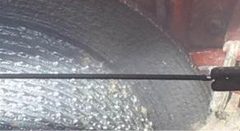Postalloy Tubular Hardfacing Electrodes from Postle are a unique concept in hardfacing technology. As a tubular electrode, they are filled with the highest percentage of carbide forming alloys, much more (20 percent+) than any other Tubular Flux-Cored Wire. This gives much better wear resistance and overall product performance.
They were engineered to provide extended life to parts subject to wear due to abrasion, impact and erosion. And because they deposit faster and there is almost no waste, they are much more economical to use.
There are three main problems to consider when hardfacing using “conventional” electrodes: recovery rate, deposition rate and dilution: first pass hardness.
Recovery Rate. Due to smoke, slag and splatter, and stub loss most arc rods only recover about 60 percent of the weight of each rod. For every 10 lb. used only 6 lb. are deposited on the base metal. The other 4 lb. are wasted. Postalloy Tubular Electrodes are more than 90 percent efficient. This equates to 9 lb. of hardface material laid down for every 10 lb. of electrodes purchased.
Deposition Rate. This is the amount of material a welder can burn per hour. Burning more than 3 to 5 lb. of “conventional” arc rods per hour is practically impossible by one welder. That means the most hardface a welder can deposit on the base metal in one hour is 60 percent of 10 lb. at the very best. That is 6 lb. out of 10. Not very efficient! When using Postalloy Tubular Electrodes, like the 215HD, you can expect up to 10 lb. per hour. In the past you could only achieve this type of rate with wire products.
Dilution. Many times, general-purpose hardface rods take two or three passes, one on top of the next, to get to full hardness and abrasion resistance because of the dilution of the deposit by the base metal. Because of the cost of labor and downtime most often only one pass is applied, this means most deposits never get to the full hardness.
Postalloy Tubular Electrodes are much higher in alloy content and use a significantly lower amperage to run. This means less dilution from the base metal resulting in higher first pass hardness.

These products are more efficient, lay down faster and are higher alloyed, to counter the effects of base metal dilution. For example, the 215HD recovers more than 90 percent of its weight, deposits 10 lb. per hour and lays down at 60 RC. When all the factors are considered the “less expensive” choices are not always the most economical choice.
Figure the cost of a typical hardface application.
- Welder earns $25 per hour.
- He uses 50 lb. of general-purpose hardface rod (60 percent recovery rate) = 30 lb. deposited.
- He can deposit 5 lb. per hour maximum.
Divide the amount rod by the deposition rate.
- 50 lb. divided by 5 = 10 hours.
- Cost of the welder for 10 hours at $25 per hour = $250.
- Cost of rod at $8 per lb. (Avg.) = $400.
- Total cost of application = $250 + $400 = $650.
Compare this to the same application with the 215HD.
- Because of better recovery (more than 90 percent), only 33 lb. are needed to deposit the same 30 lb.
- Deposition rate is 10 lb. per hour.
Divide the amount rod by the deposition rate.
- 33 lb. divided by 10 = 3.3 hours.
- Cost of the welder for 3.3 hours at $25 per hour = $80.
- Cost of rod at $11 per lb. = $363.
- Total cost of application = $80 + $363 = $443.

When you consider all factors, Postle tubular products are much more economical to use than the “conventional” hardfacing rod. In addition to being more economical to use, with the much higher alloy content and less dilution it is not uncommon to get a double or even triple wear life. This makes Postalloy Tubular Hardface Electrodes a much better choice in the long run, affirmed the company.
Postle Industries, www.postle.com

